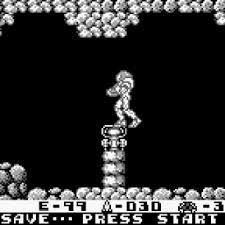It will surprise nobody who knows me that I got lost, and often, throughout my time with Metroid II: Return of Samus. It’s not that it’s a huge game, really, it’s just that it’s in black and white, it’s big enough, and it seems to take pride in re-using some environments for the sake of making the player lose any sense of directional bearing.
Also, I have no sense of direction. I spent a lot of time — a lot of time — taking the controls while my brother barked directional instructions at me when we were kids. Spatial reasoning has never come easily to me; I can read a map just fine, but put me in the middle of a city and tell me to find my way out of it, and I might remain trapped forever.
Of course, I’m too stubborn to actually draw maps as I go…but I digress.
About halfway through Metroid II, I got lost. Hopelessly lost. I had done what I needed to do to that point, I had fought and won against a handful of “gamma metroids”, and I’d picked up a mess of missiles and a couple of energy tanks along the way. I followed the implied suggestion of the game to clear an area of metroids, let the energy-draining lava that blocks off other areas recede, and then move on to the next area. It seemed like a nice way to let the game dictate where I should be at any given point, something the game uses to keep the world from getting too big at any given point. But then I got lost, running around in circles, bombing every wall, checking each area once, twice, three times for secret passages.
Finding nothing, my resolve fell.

As it turns out, a combination of a few energy tanks and the half-damage ability of the varia suit allows for the ability to go through the lava-filled passages into segments of the game that theoretically shouldn’t be open yet.
Really, this is a strength of the game, given that the ability to go into these areas opens up the game in a way that will appeal to those who don’t care for forced linearity. You can seek out and find a few of the overpowered omega metroids if you like, you can get a look at terrains that you’ve never seen, you can practice fighting enemies that you’d only seen in the instruction book to that point, and you can save your game in areas that you’re not supposed to be. You can explore the entire world of Metroid II, aside from perhaps the final boss, once you can withstand enough punishment to speed your way through the lava.
The problem with subverting the intention of the lava is that the entire point of the game is to eradicate all of the metroids, not to get to some predetermined destination. If you go exploring in places you shouldn’t be, you are necessarily increasing the scope of your search for those metroids, and when you get to the point where, say, you have one left, you have the entire world of the game to explore, rather than one comparatively smaller section of it.
That said, it’s difficult to resist the pull of new things, especially when you’re not entirely sure whether the lava is truly telling you not to move on. The last retro game I spent this amount of time with was The Legend of Zelda, a game that delights in slowly breaking down the rule set it establishes early on, forcing the player to consider possibilities about the world that would have seemed impossible in the early going (walking through walls, whistle-triggered staircases, and so on, particularly in the game’s second adventure). Unable to find the metroid that would trigger another lava-clearing earthquake, the question lingered: was I supposed to be navigating my way through the lava to progress? What if my self-imposed limitation, my understanding of the implications of the game’s mechanics thus far, were hindering my ability to conquer it?

Don’t do it!
Until I did finally figure out what I was missing, a simple strategy allowed for the exploration I needed: go where I like, but don’t save until I have an answer to my question. Metroid II‘s usage of save points allowed for the approach, and my own fear of trapping myself somewhere I shouldn’t be was enough to get me to restrain myself from using them — no matter how off-track I got, I knew that the simple act of video game suicide would return me to familiar territory. Eventually, I did find the metroids I’d been missing, and I didn’t have to go through the lava to get to them.
And thank god, because I might have been at this game for months (or until I dropped it for a prettier, newer game).
The ability to subvert a game’s implicit rule set is one of the things that makes even playing a video game a creative experience. The way you play is unique to you. Whether it appeals to you, however, may depend on how willing you are to accept the consequences of that subversion. Subverting a game’s rules terrifies me, at least until I’m familiar enough with it to turn it into my own personal sandbox; I’d rather see what it has to offer on something as close as possible to its own terms before I start forcing it to conform to mine. Now that I’ve beaten Metroid II, I’m much more willing to go in and try to break it.













